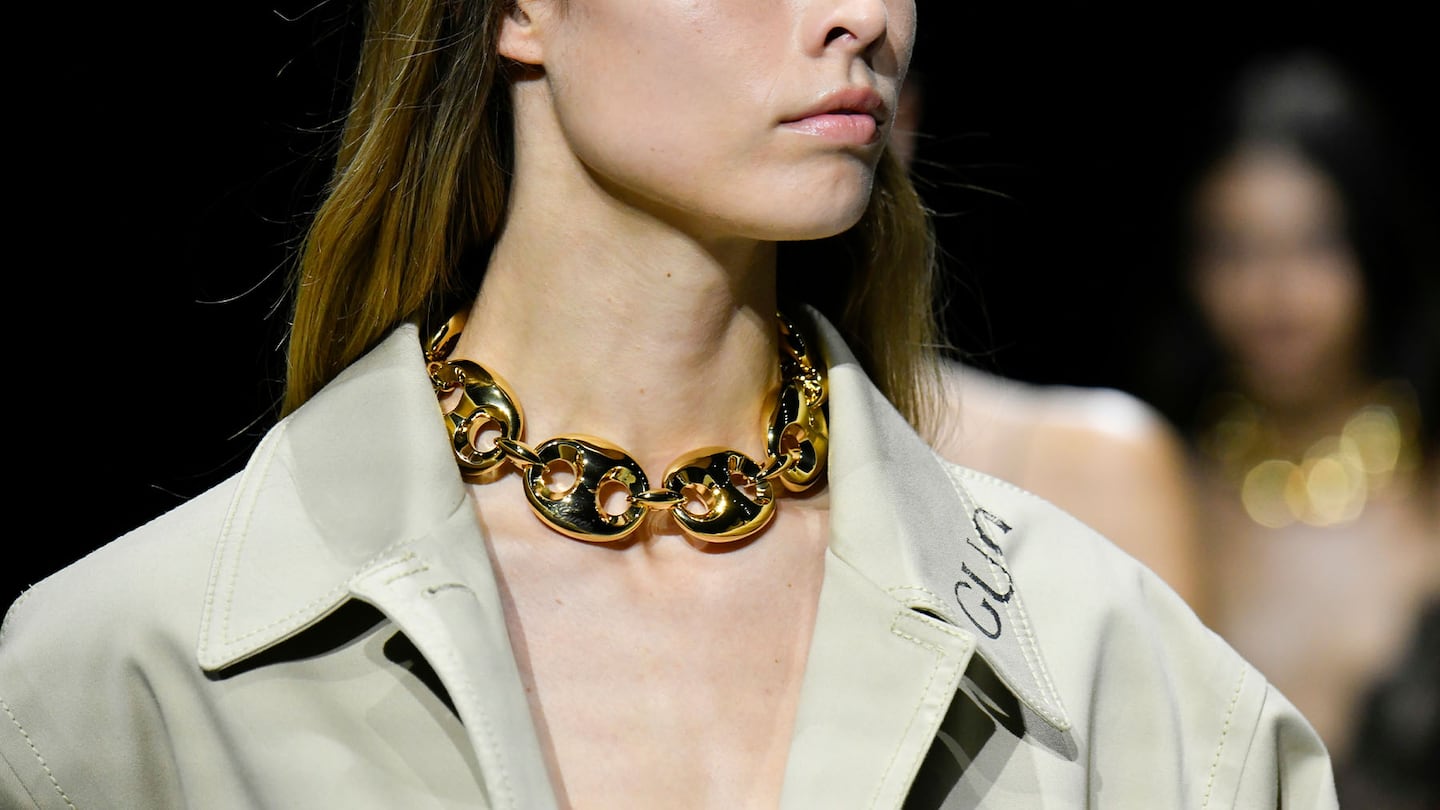
The Business of Fashion
Agenda-setting intelligence, analysis and advice for the global fashion community.

Agenda-setting intelligence, analysis and advice for the global fashion community.

PARIS — Gucci’s lengthy turnaround is far from over, owner Kering warned Thursday.
The French group, luxury fashion’s second-biggest player, reported fourth-quarter revenues that fell 4 percent on a comparable basis, in line with estimates but far behind key rivals: Louis Vuitton- and Dior-owner LVMH grew sales 10 percent in the last quarter, while Cartier-owner Richemont saw revenues increase by 8 percent.
Still, Kering sales showed some improvement over the previous quarter, when revenues tumbled 9 percent. The results were “tolerable, with no major negative surprises,” wrote RBC Capital Markets analyst Piral Dadhania. Shares rose 5 percent in Paris trading.
Much depends on the future of Gucci, which accounts for more than half of Kering’s revenues and about two thirds of its operating profit. And with an attempt to re-energise the brand under intense scrutiny after revenue fell 2 percent last year, Kering’s leadership warned investors that a turnaround at Gucci is unlikely to be swift or dramatic.
ADVERTISEMENT
“Revenues should not grow significantly this year for Gucci, even if the reception of the new collections by Sabato has been very encouraging,” deputy chief executive Jean-Marc Duplaix said, referring to new designer Sabato De Sarno. Markets should expect modest growth at Gucci from the second half of the year, while operating profits are likely to decline by a mid-single-digit percentage, Duplaix added.
Gucci has struggled to reinvigorate sales after a historic boom under designer Alessandro Michele and chief executive Marco Bizzarri ran out of steam. An overhaul of the brand’s image and product offering by De Sarno is just being rolled out to stores.
Gucci remains “a cultural icon, and a brand that has its place in the premier league,” Kering chairman François-Henri Pinault said.
But a strategy announced in 2022 that aims to walk the tightrope between offering the kind of fashion magic that propelled Gucci to new heights under Michele and building a more stable and luxurious brand platform will need more time. Private stores, top-end products like high-jewellery and exotic leather handbags, and a revamped luggage program won’t attract enough of the top-end clients who are driving growth for luxury rivals anytime soon.
Meanwhile, four years after the coronavirus pandemic reshaped the landscape for luxury fashion, the droves of organised tour groups and daigou resellers who used to help power brands’ entry-level business have yet to return. At the same time, the ranks of spendthrift streetwear fans who lined up for drops of luxury sneakers have shrunk, too.
A surge of local clients from the American and European middle class had helped to plug the gap in 2021 and 2022, but many of those clients have since pulled back spending on fashion amid rising interest rates, economic uncertainty and the return of restaurants and travel.
It’s high-end clients who are driving the market now.
For several years, surging sales in Kering’s other units helped to soften Gucci’s slowdown. Now, the struggle to make up for lower demand for the more accessible, fashion-driven luxury brands that dominate Kering’s portfolio has become group-wide.
ADVERTISEMENT
Saint Laurent sales fell 1 percent last year, including a 5 percent drop in the fourth quarter. Bottega Veneta’s sales slipped 2 percent last year, while the group’s “other” luxury division, comprising Balenciaga, Alexander McQueen and Boucheron, fell 8 percent.
Markets may decide to brush off the slowdown at Saint Laurent as an understandable correction following a multi-year surge in the US, a tricky market for many brands in 2023.
Meanwhile at once white-hot Balenciaga, sales in Asia are improving, but the brand has struggled to bounce back in the US from an ill-received marketing campaign that put the brand at the centre of America’s culture war, pushing sales off a cliff in the key market.
Kering’s full-year revenues fell 2 percent on an organic basis to €19.6 billion ($21.15 billion), while full-year operating profit of €4.75 billion was slightly below estimates.
A move to accelerate plans to cut down on brands’ wholesale exposure may be part of the issue. Balenciaga and Bottega Veneta were among labels that sped up plans to cut back on wholesale last year. (Same-store sales grew 5 percent in Bottega Veneta’s retail stores in the fourth quarter, even as overall revenues fell by 4 percent, the company said).
Still, none of Kering’s brands seems to be exempt from the challenges facing brands across the industry that were over-dependent on aspirational luxury. “All of our brands are moving forward with top clients; all of our brands are struggling with the aspirational customer,” Saint Laurent CEO and newly appointed Kering deputy CEO Francesca Bellettini said.
Reinvigorating sales will require continuing to invest in the bold creative visions of designers, who will need to keep creating novel, accessible luxury products and bold advertising concepts to reactivate the aspirational segment, Pinault said.
At the same time, the group hopes to rebalance its profile, concentrating its resources on reinforcing the long-term investment appeal of core categories like handbags, while also expanding its top-end business through couture and high jewellery.
ADVERTISEMENT
“We are very strong in the aspirational segment of customers. That’s allowed us to reach new levels of brand recognition and desirability. Now we are building on that to grow in the high-end segment,” chairman and CEO François-Henri Pinault said.
The concern is just how long it can take for a company to convince customers it is credible in a new segment: Burberry’s long-term strategy to push upmarket and become a luxury pure-player has required a decade of anaemic growth.
Still, Kering’s brands don’t have quite as far to go as Burberry. While products like Gucci low-top sneakers and Bottega Veneta card holders have historically been more accessibly priced than those of labels like Louis Vuitton and Dior, the way Kering’s brands have long blended luxury and cutting-edge creativity has helped the company attract top-spending VICs (very important clients) albeit in smaller proportions than many rivals.
Pinault flagged Balenciaga’s budding haute couture program, as well as loyal clients who buy deeply into its ready-to-wear as helping the brand to bounce back from scandal.
New designer Sabato De Sarno is thrown in at the deep end as the brand aims for a turnaround, writes Tim Blanks.
Luxury’s biggest pre-pandemic success story is reinforcing its high-end credentials as it works to transition from an era of fashion-driven ‘reinvention’ to a new chapter of ‘sustainable elevation.’
The ultra-wealthy are spending more on luxury than ever before — and, amid a broader market slowdown, winning them over is becoming a competitive battleground for brands. BoF breaks down how strategies from Gucci, Mytheresa and Tiffany & Co. are successfully building closer relationships with top clients.

Robert Williams is Luxury Editor at the Business of Fashion. He is based in Paris and drives BoF’s coverage of the dynamic luxury fashion sector.
The designer has always been an arch perfectionist, a quality that has been central to his success but which clashes with the demands on creative directors today, writes Imran Amed.
This week, Prada and Miu Miu reported strong sales as LVMH slowed and Kering retreated sharply. In fashion’s so-called “quiet luxury” moment, consumers may care less about whether products have logos and more about what those logos stand for.
The luxury goods maker is seeking pricing harmonisation across the globe, and adjusts prices in different markets to ensure that the company is”fair to all [its] clients everywhere,” CEO Leena Nair said.
Hermes saw Chinese buyers snap up its luxury products as the Kelly bag maker showed its resilience amid a broader slowdown in demand for the sector.